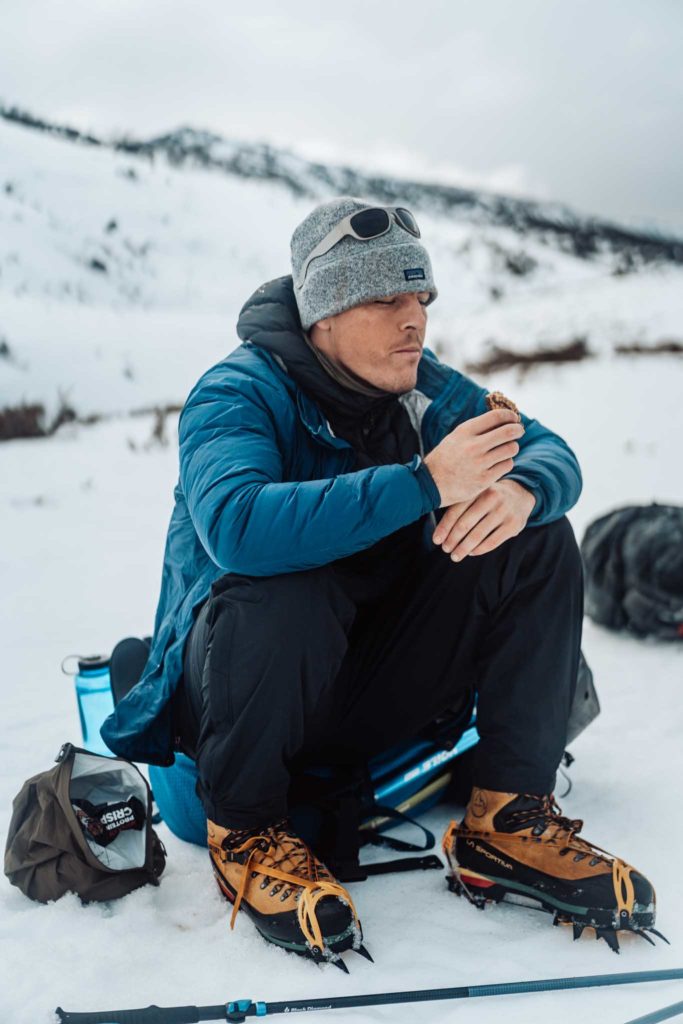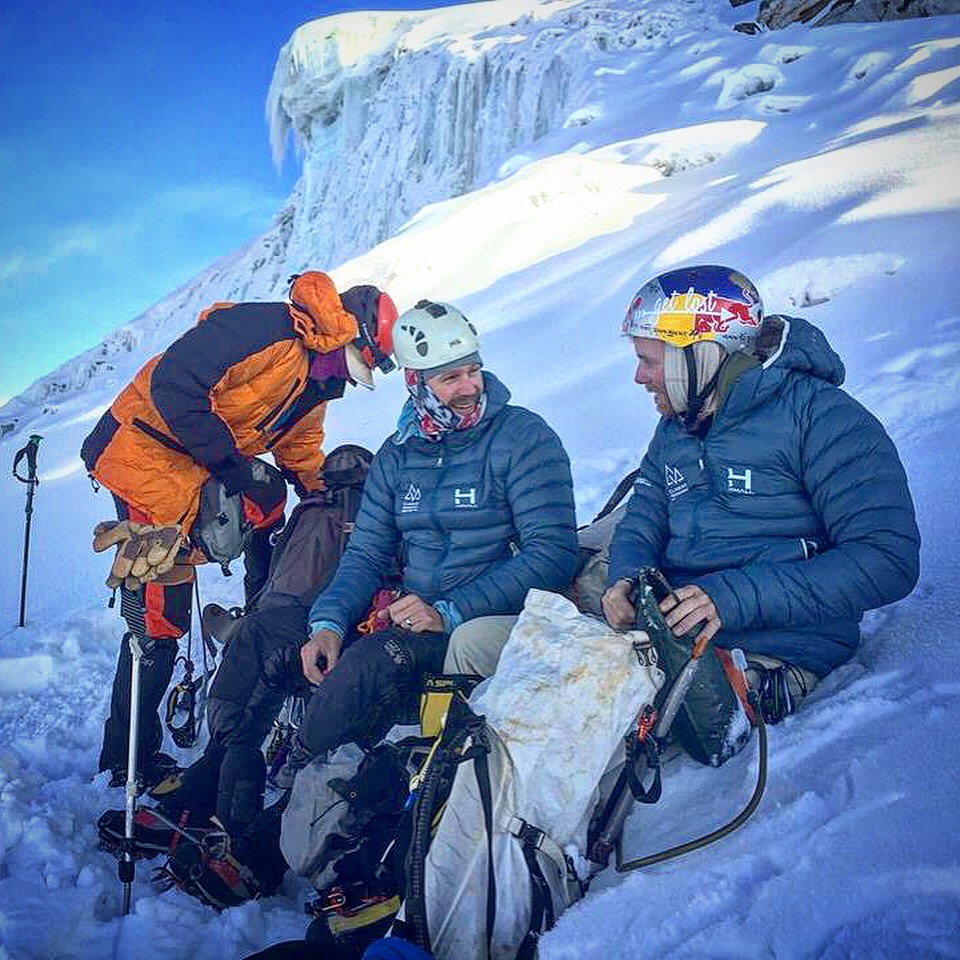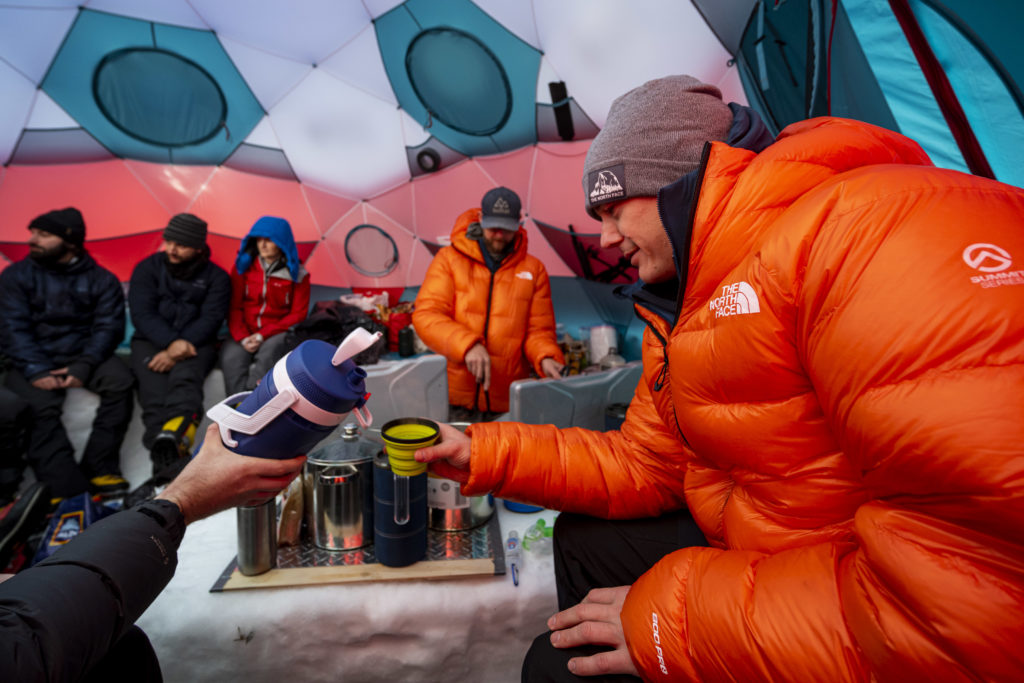Nutrition Tips for Mountaineers
You’ve got a 20-day expedition to Aconcagua on the horizon. After reviewing the gear list, you quickly realize that you’ll need to bring personal snacks for the mountain—but not just any snacks. You’re asked to bring snacks that you will actually want to eat (at altitude) and that will give you the fuel you need. As the gear list puts it, “Bring food you know fuels you well and you want to eat. Bring a variety.” Would you be stumped at the supermarket as to what to choose?
Enter Rebecca Dent, our go-to sports dietitian and nutrition coach who specializes in supporting mountain athletes (both recreational and elite) to achieve peak performance through personalized and easy-to-put-into-practice nutrition strategies.
We sat down with Rebecca to chat nutrition in the mountains, and we are excited to share some of her top tips, along with some of our own guide-approved tips that will ensure you are prepared, fueled, hydrated, and primed for a speedy recovery during your next jaunt in the backcountry.
Plan Ahead
 Showing up to the mountain with food you’ve never eaten before is a recipe (pun intended) for an unhappy belly. The food and fuel you bring into the backcountry are just as important as remembering to bring your ice axe and crampons and knowing how and when to use them effectively.
Showing up to the mountain with food you’ve never eaten before is a recipe (pun intended) for an unhappy belly. The food and fuel you bring into the backcountry are just as important as remembering to bring your ice axe and crampons and knowing how and when to use them effectively.
So, when it comes to food and fuel in the big mountains, let’s employ the same train of thought. Train your body to use and appreciate quick refuel stops and to eat while you are on the move before you get on expedition, just like you train yourself to use an ice axe. Here are our first tips:
- When you’re training for your expedition, make snacking part of that training routine so your body gets used to consuming high-calorie snacks mid-movement. By training your body to snack efficiently, it’ll be easier on the mountain.
- Keep your snacks diverse, it makes for more enjoyment on the mountain.
- When snack training, mix regular foods (e.g., nuts) with smart foods (e.g., energy gels, bars).
By regularly training and snacking, you will feel more comfortable and have a better grasp on what you like, what is easy to consume, and most importantly, what works for your unique body, before you get on an expedition.
Rebecca’s Tip: “It’s important to plan and practice your mountain nutrition strategy more than once before you go on expedition. This will help you remember to eat and drink on the mountain and give you confidence that you have a strategy that works for you.”
Fuel
We like to think about fuel (or food) in two ways; your regular foods and your science or smart foods. Regular foods include things like nuts, chips, candy bars, dried fruit, or anything else that you might pick up at the grocery store or gas station. Smart foods include things like gels, bars, energy gummies, and powders.
When you’re in the mountains, you should be aiming for 200 to 400 calories per snack at a rate of one snack per hour while moving. Here are a few helpful examples and tips on how to optimize fueling yourself with snacks.
 Technical Terrain: We recognize that sometimes when you’re moving through technical terrain, think glaciated slopes or ice climbing, you can’t sit down for a snack every hour. You can’t eat anything fiddly, either. So, having those snacks inaccessible places in your jacket pocket and having your body trained to access them and eat them will increase your chances for success in the mountains. An energy gel (smart food) is going to be perfect in this situation.
Technical Terrain: We recognize that sometimes when you’re moving through technical terrain, think glaciated slopes or ice climbing, you can’t sit down for a snack every hour. You can’t eat anything fiddly, either. So, having those snacks inaccessible places in your jacket pocket and having your body trained to access them and eat them will increase your chances for success in the mountains. An energy gel (smart food) is going to be perfect in this situation.- Alpine Starts: On summit day, your day will usually start at about 2 or 3am. You’ll get up, have breakfast, and start climbing up and up through the early hours. And as you might imagine, eating breakfast that early in the morning can be tough! Give yourself a head start by carbohydrate-loading your dinner the night before. Those carbs will show up for your muscles the next day and provide you with the necessary fuel. Once you’re awake, stick to things that are easy to digest and get down when you are half asleep. We often lean into drinks and meal replacements when we have an alpine start and then snack extensively throughout summit day. This leads to our next pointer…
- Lunch All Day: In the mountains, we have a saying: lunch starts at breakfast and ends at dinner. We say this for two reasons: 1) we want you to be constantly fueled (or refueled) so you never go into a calorie deficit, and 2) there’s usually not enough time on summit day to take a big, long lunch break. Instead, we take smaller, more frequent rest stops, and that schedule suits snacking better. By snacking and eating your regular snack food throughout the day, you’ll feel stronger all day. Some of our favorite “real food” snacks are salted nuts, nut butter, jerky, cheese, etc.
Rebecca’s Tip: “The higher up the mountain you go, the easier the fuel needs to go down think sports gel, liquid calories, gummies, or your favourite candy.”
Hydration
A great day in the mountains means you start your day hydrated, and hydration starts days before you actually step onto the mountains. Keep this in mind as you travel to your destination. Airlines rarely serve water often enough, and the dry climate-controlled air pulls moisture out of our bodies quickly. Even if you can’t take a full water bottle onto the plane, bring an empty, wide-mouthed water bottle and ask your flight attendants to refill it.
 Once you are on expedition, spend your morning hydrating for the day to come. If you step onto the trail well-hydrated, it is much easier to stay ahead of the dehydration throughout the day. Before you’re moving for the day, check in with your guide on water strategy, meaning the frequency and amount of water to carry and consume. They will be able to help you balance the weight against your refill ability, which is mountain-dependent. We also understand that some people have a really hard time drinking plain water, so we suggest making it more palatable by adding in an electrolyte drink tab. That will make it more tempting while amping up your fuel and water intake. Remember, just because it has electrolytes doesn’t mean you need less water! Another great way to reach your daily hydration needs is to mix in caffeine-free herbal tea, like chamomile. We often turn to hot tea in a small thermos on cold peaks or at the end of the day as a way to relax and rehydrate.
Once you are on expedition, spend your morning hydrating for the day to come. If you step onto the trail well-hydrated, it is much easier to stay ahead of the dehydration throughout the day. Before you’re moving for the day, check in with your guide on water strategy, meaning the frequency and amount of water to carry and consume. They will be able to help you balance the weight against your refill ability, which is mountain-dependent. We also understand that some people have a really hard time drinking plain water, so we suggest making it more palatable by adding in an electrolyte drink tab. That will make it more tempting while amping up your fuel and water intake. Remember, just because it has electrolytes doesn’t mean you need less water! Another great way to reach your daily hydration needs is to mix in caffeine-free herbal tea, like chamomile. We often turn to hot tea in a small thermos on cold peaks or at the end of the day as a way to relax and rehydrate.
Rebecca’s Tip: “Think drip feed. This means frequent little sips throughout the day when you are in the mountains. It won’t always be practical or safe to stop to eat and drink so get used to eating and drinking on the go.”
Recovery
Recovery starts immediately at the end of your day, especially if you are doing a multi-day expedition. We focus on the four R’s of Recovery, including:
- Rehydrate: You lose a lot of fluid when you are in the mountains, mainly through sweating and exhaling in dry air. This means that when you have a big day in the mountains, you need to drink water not just before and during the day but also after you are done trekking or climbing.
- Refuel: You’ve been working hard all day, and now your energy levels are depleted. It’s time to eat so you can replenish what you’ve lost. Focus on carbohydrates and protein, and use recovery powders, drinks, and bars to help give you a leg up.
- Repair: A big expedition undoubtedly wears on your muscles. Here’s what’s actually happening—you’re experiencing micro-muscle tears, which is how our body builds muscle over time. In the backcountry, we need to quickly repair our muscles with high-protein foods.
- Rest: When your rest day arrives, take full advantage. Or once you hit base camp for the night, catch some sleep instead of staying up late. Sleep is one of the easiest ways to keep your body functioning at a high performance level. Don’t underestimate the power of a good night’s rest!
Dialing in your nutrition strategy is arguably just as important as your physical and mental preparations. If you’re ready you’ll get more enjoyment out of your mountain trip, keeping you safer and increasing your chances of summit success.
Rebecca’s Tip: “At the end of the day, when you get back to camp, start to rehydrate and refuel as soon as possible. Adding an electrolyte to your water or sipping on a recovery shake will help aid the absorption of water.”
Ready for more?
Ask Rebecca all your high-performance nutrition questions during our live webinar, access resources from Rebecca when you climb with us, and work with Rebecca one-on-one to develop a nutrition plan for the backcountry that works individually for you!
- Learn with us! Check out our live webinar below with Rebecca Dent.
- Climb with us! When you climb with CTSS, your onboarding documents include a PDF from Rebecca to support your nutrition in the mountains.
- Work with Rebecca! Book a free Discovery Call to discuss your mountain goals and learn how she can help. Click here to schedule.